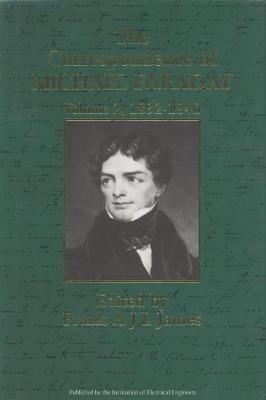
The Correspondence of Michael Faraday
1832-1840
Seiten
1993
Institution of Engineering and Technology (Verlag)
978-0-86341-249-3 (ISBN)
Institution of Engineering and Technology (Verlag)
978-0-86341-249-3 (ISBN)
Volume 2 covers the 1830s, a period when Faraday pursued the consequences of his discovery of electromagnetic induction and revised entirely the theories of electrochemistry and the nature of electricity. His correspondents include scientists of the day as well as antiquaries, military men, artists and politicians.
Michael Faraday (1791-1867) was one of the most important men of science in nineteenth century Britain. His discoveries of electromagnetic rotations (1821) and electro-magnetic induction (1831) laid the foundations of the modern electrical industry. His discovery of the magneto-optical effect and diamagnetism (1845) led him to formulate the field theory of electro-magnetism, which forms one of the cornerstones of modern physics.
These and a whole host of other fundamental discoveries in physics and chemistry, together with his lecturing at the Royal Institution, his work for the state, his religious beliefs and his lack of mathematical ability, make Faraday one of the most fascinating scientists ever.
All these aspects of his life and work, and others such as his illnesses, are reflected in his correspondence. This volume, in which over 70% of the letters are previously unpublished, covers most of the 1830s. During this period, Faraday pursued the consequences of his discovery of electromagnetic induction, demonstrated the identity of electricities and revised entirely the theories of electro-chemistry (in the process coining now familiar words such as electrode, cathode and ion) and the nature of electricity.
His correspondents in this volume include men and women of science (such as William Whewell, Charles Babbagc, G.B. Airy, J.D. Forbes, Joseph Henry, Alexander von Humboldt, Macedonio Melloni, Christian Schoenbein, Ada Lovelace and Mary Somerville), antiquaries (such as John Gage and Thomas Pettigrew), military and naval men (such as John Barrow, Charles Pasley and Percy Drummond), artists (such as William Wyon, H.W. Pickersgill, John Constable and John Landseer) and politicians (such as Prime Minister Lord Melbourne, Lord Holland and many members of the Holland House circle).
The Correspondence will be a valuable resource for historians and sociologists of science, as well as historians of the nineteenth century and the industrial revolution. It will also be of great interest to electrical engineers, physicists and chemists who want to know more about one of the most eminent figures in their history.
Michael Faraday (1791-1867) was one of the most important men of science in nineteenth century Britain. His discoveries of electromagnetic rotations (1821) and electro-magnetic induction (1831) laid the foundations of the modern electrical industry. His discovery of the magneto-optical effect and diamagnetism (1845) led him to formulate the field theory of electro-magnetism, which forms one of the cornerstones of modern physics.
These and a whole host of other fundamental discoveries in physics and chemistry, together with his lecturing at the Royal Institution, his work for the state, his religious beliefs and his lack of mathematical ability, make Faraday one of the most fascinating scientists ever.
All these aspects of his life and work, and others such as his illnesses, are reflected in his correspondence. This volume, in which over 70% of the letters are previously unpublished, covers most of the 1830s. During this period, Faraday pursued the consequences of his discovery of electromagnetic induction, demonstrated the identity of electricities and revised entirely the theories of electro-chemistry (in the process coining now familiar words such as electrode, cathode and ion) and the nature of electricity.
His correspondents in this volume include men and women of science (such as William Whewell, Charles Babbagc, G.B. Airy, J.D. Forbes, Joseph Henry, Alexander von Humboldt, Macedonio Melloni, Christian Schoenbein, Ada Lovelace and Mary Somerville), antiquaries (such as John Gage and Thomas Pettigrew), military and naval men (such as John Barrow, Charles Pasley and Percy Drummond), artists (such as William Wyon, H.W. Pickersgill, John Constable and John Landseer) and politicians (such as Prime Minister Lord Melbourne, Lord Holland and many members of the Holland House circle).
The Correspondence will be a valuable resource for historians and sociologists of science, as well as historians of the nineteenth century and the industrial revolution. It will also be of great interest to electrical engineers, physicists and chemists who want to know more about one of the most eminent figures in their history.
Frank A.J.L. James is Lecturer in History of Science at the Royal Institution Centre for the History of Science and Technology. He has written on physics and chemistry in the nineteenth century and has previously edited the Diary of Herbert McLeod, published by Mansell. With Geoffrey Cantor and David Gooding he has written the biography Faraday, published by Macmillan. Frank James lives in London and is married with three children.
The Correspondence
Previous Publication of Letters
Bibliography
Index
| Reihe/Serie | History and Management of Technology |
|---|---|
| Verlagsort | Stevenage |
| Sprache | englisch |
| Maße | 145 x 228 mm |
| Themenwelt | Literatur ► Biografien / Erfahrungsberichte |
| Geschichte ► Teilgebiete der Geschichte ► Technikgeschichte | |
| Naturwissenschaften ► Physik / Astronomie ► Elektrodynamik | |
| Technik ► Nachrichtentechnik | |
| ISBN-10 | 0-86341-249-1 / 0863412491 |
| ISBN-13 | 978-0-86341-249-3 / 9780863412493 |
| Zustand | Neuware |
| Informationen gemäß Produktsicherheitsverordnung (GPSR) | |
| Haben Sie eine Frage zum Produkt? |
Mehr entdecken
aus dem Bereich
aus dem Bereich
Buch | Softcover (2024)
Lehmanns Media (Verlag)
CHF 27,90
Eine superschnelle Menschheitsgeschichte des digitalen Universums
Buch | Hardcover (2024)
Heyne (Verlag)
CHF 33,55


